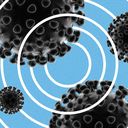America's split on whether the pandemic is over

Free COVID tests are over, for now. So are guidelines for infected people to isolate. Half of the country thinks the pandemic is finished.
- But, in reality, COVID-19 is still with us. Though the official trappings of the crisis keep fading away and it's increasingly being treated like the flu, the virus remains an ever-present threat that's killing hundreds of Americans every week and consuming health care dollars and resources.
The big picture: This split screen effect was apparent this week when the government said it would stop distributing free COVID tests amid lower case rates. That followed the Centers for Disease Control and Prevention easing isolation guidance from five days to 24 hours.
- But just a week before, the CDC recommended that older adults get another booster shot this spring. And many hospitals brought back their mask mandates during a wintertime surge of cases.
- Public health experts are split over whether the virus should be treated as a singular threat or lumped with other respiratory diseases.
The entire COVID experience has left the country uncertain precisely what a pandemic is, or who gets to say when it starts and ends. Even Ashish Jha, President Biden's former White House COVID-19 response coordinator, says it's a hard question to answer.
- "For all intents and purposes, yeah, the acute phase of the pandemic is over," he said. "The challenge is, we are left with a virus that will be around forever, that continues to cause serious problems ... not for everybody, but for a chunk of our population."
Ways the pandemic is over
Lockdowns, widespread masking, broad data collection and many other public health orders are in the past, and people now act largely on their own perceptions of risk.
- That was to be expected as the public health emergency was lifted and hospitalizations and deaths fell.
- The populist backlash to the pandemic response and ensuing lawsuits and legislation also left health officials in a much weaker position to close schools or businesses, limit the size of gatherings or require vaccinations.
- A fatigued public, meanwhile, now puts the threat of COVID on a par with unsafe driving, smoking or alcohol abuse — and far behind top health concerns like opioids and obesity.
- A new Pew Research Center report found only 20% of Americans view the coronavirus as a major health threat, and that 28% of U.S. adults say they have received the updated COVID-19 vaccine.
- A February Axios-Ipsos survey found 17% of adults reported wearing a mask in public, down from 30% a year earlier.
Ways the pandemic still is with us
But many Americans still are taking personal precautions. Vaccines are being updated and the government is spending billions of dollars searching for treatments to long-term COVID symptoms from brain fog to organ failure.
- Many immunocompromised people still view COVID as a significant threat, and they feel left behind by the new relaxed isolation guidelines.
- The World Health Organization also still refers to COVID as a pandemic. Although it declared the global health emergency done in May, WHO still cautions that new variants could cause COVID surges and deaths down the road.
- The virus is circulating at a high level across the country and especially in the South, according to wastewater surveillance data collected by the CDC. For example, 32 wastewater treatment sites in Virginia have high viral activity levels.
- Hospitals admitted more than 17,300 people with COVID in the week ending Feb. 24, though that's a 10% decline from the pervious week, according to the most recent CDC data.
- Beyond case counts and personal protection, the pandemic remains imprinted on American politics. Republican-led House hearings have dissected the pandemic response for more than a year.
- Pandemic preparedness legislation to fortify stockpiles for future outbreaks has stalled in Congress amid partisan bickering. And debates over vaccines — including anti-vax conspiracy theories — have seeped into primary fights and presidential politics.
The bottom line: "There's a huge, natural tendency to want to go back to normal after an emergency," said Joshua Sharfstein, a former principal deputy commissioner of the Food and Drug Administration and now vice dean at Johns Hopkins Bloomberg School of Public Health.
- "You can kind of feel that pull to just [pretend] that we're back in a world where COVID didn't exist. But alas, we're not," he said.
- The disease "is part of what we're going to all be living with," said Jennifer Kates, a senior vice president at KFF. "Understanding that and modifying behavior, at times, is prudent."